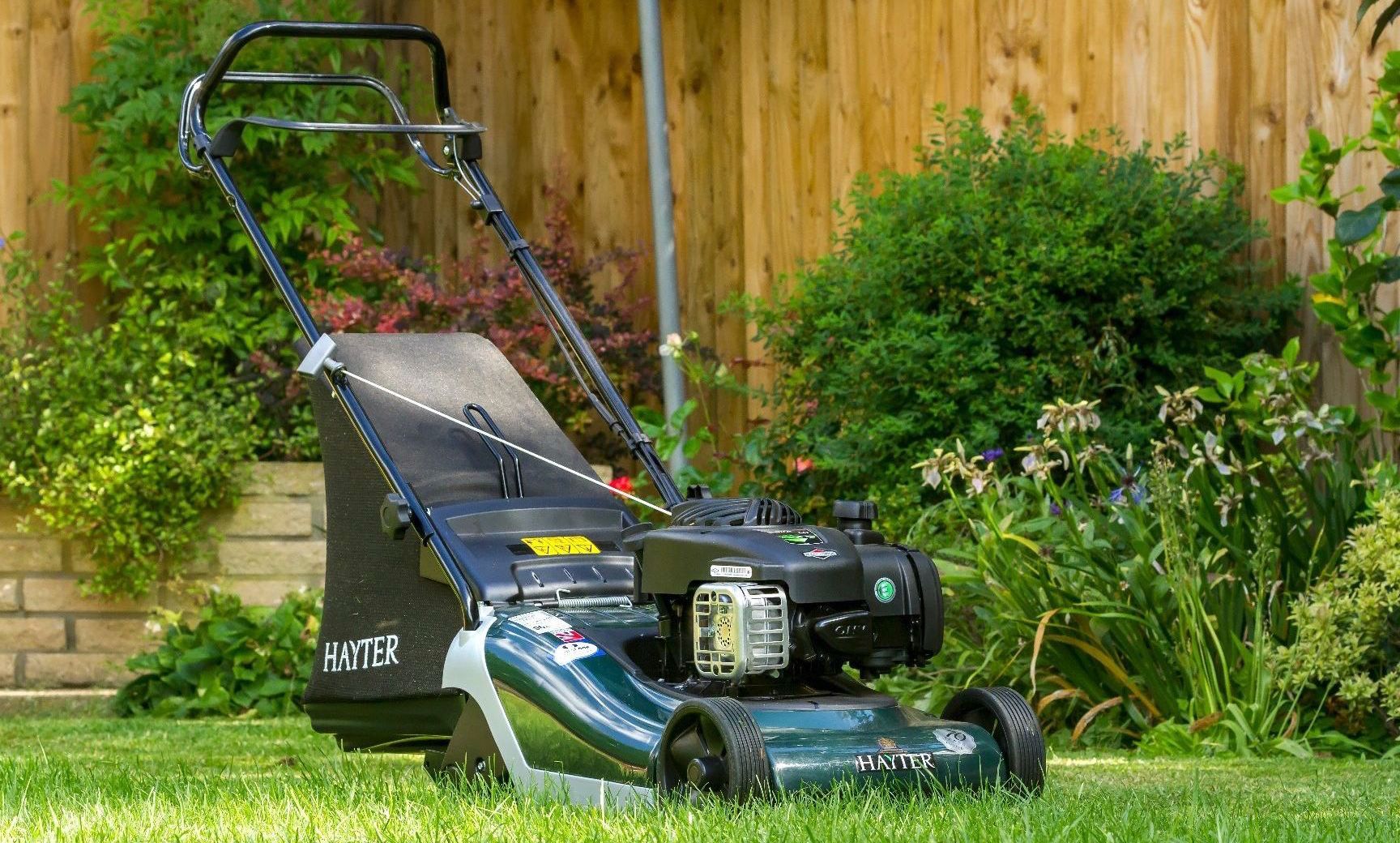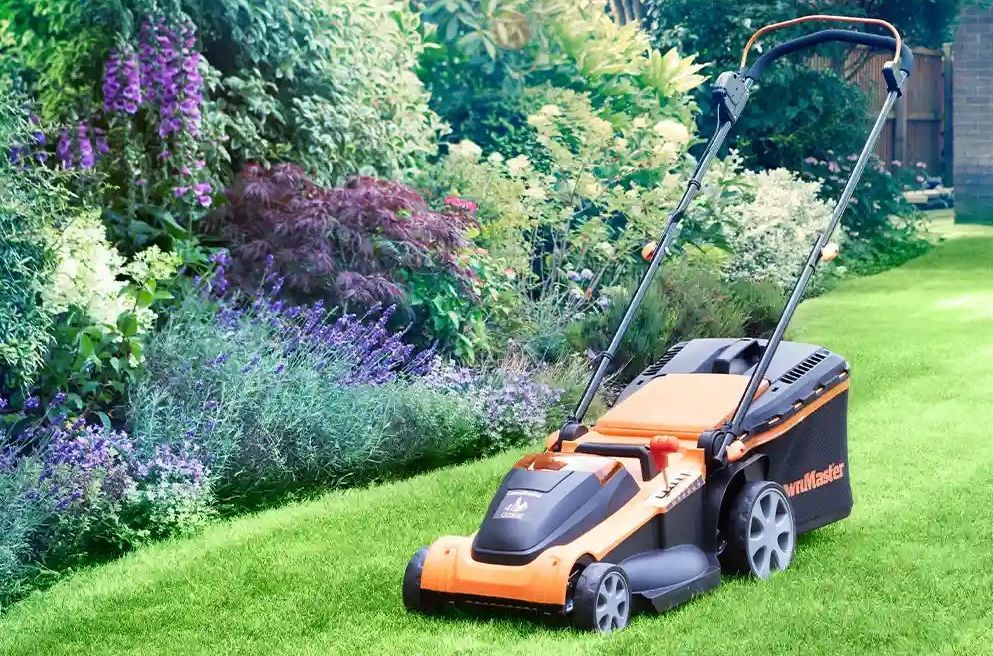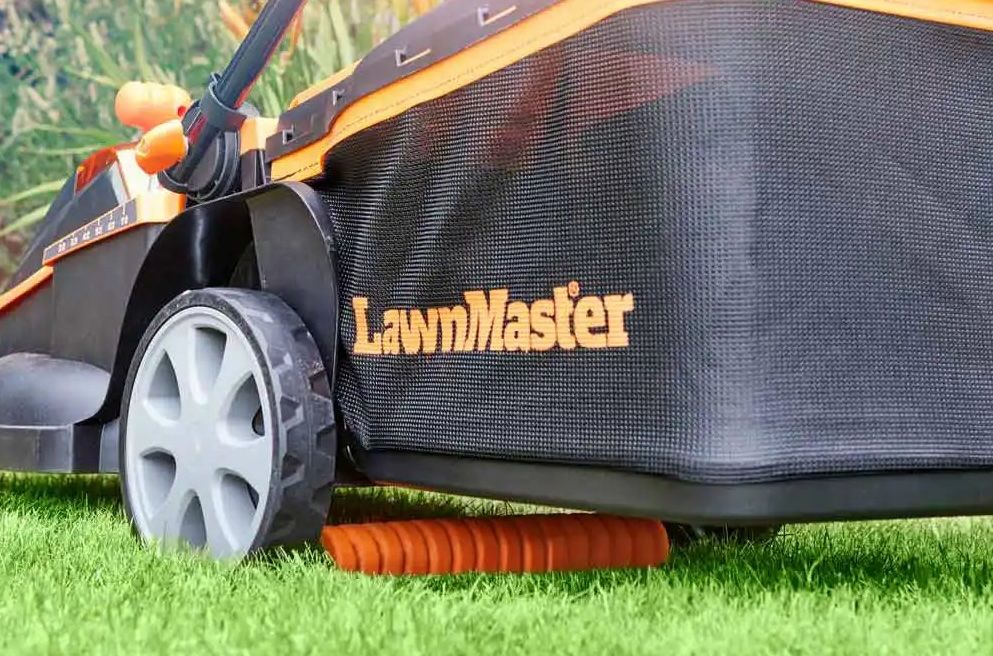*Important Information: As an audience supported website, if you purchase an item after clicking an external link or advertisement marked with an asterisk (*) on this website, we may receive a commission. This does not change the price you pay.
Wheeled mowers are by far the most popular type of lawnmower on sale in the UK today. Image Credit: Bogubogu
Chassis Design
A starting point for many lawnmower buyers is determining their chassis preference.
By chassis preference, we simply mean choosing between a wheeled mower, a hover mower, a combi-mower, or a roller mower. Each type of mower has its own benefits and drawbacks, which will inevitably vary, dependent upon the size, layout, and characteristics of your lawn.
Wheeled mowers are by far the most popular mower on sale in the UK today.
Image Credit: Bogubogu
Wheeled Mowers
Every year, millions of lawn mowers are sold around the world — and most of them have one thing in common: four wheels. As the name implies, a wheeled mower features a wheel at, or near, each corner, making it easy to push, steer, and manoeuvre across the grass.
There’s a huge variety of wheeled mowers on the market. Some are compact and lightweight — perfect for small urban gardens — while others are built to tackle sprawling lawns with power and precision. In the UK, you’ll typically find wheeled mowers powered by either an electric motor or a petrol engine, giving you plenty of options dependent upon the size and layout of your lawn.
Advantages Of Choosing A Wheeled Mower
It’s easy to see why wheeled mowers are so popular — they’ve got a lot going for them:
- Affordability: Thanks to their simple design, there's a wide range of budget-friendly corded electric, battery electric and petrol-powered models available, to help keep your garden in great shape;
- Choice: You can choose from more wheeled machines, than any other type of mower;
- Perfect for almost any lawn: Whether you’re tending to a formal lawn, or a family lawn, wheeled mowers can handle it all with ease;
- Versatility: Many wheeled mowers can also collect and shred fallen leaves — just adjust the height of cut, and you’re good to go;
- Manoeuvrability: Wheeled mowers are frequently lighter, quicker, and more manoeuvrable than roller mowers, making them easier to handle;
- Mulch-friendly: Many larger and mid-size wheeled mowers come with mulching kits, or are compatible with them, allowing you to recycle grass clippings for a healthier, greener, lawn, and reduced cutting time.
With all these benefits, it's no wonder they're an established favourite with British homeowners and householders today.
Disadvantages of Choosing A Wheeled Mower
Despite their unrivalled popularity with gardeners, if you desire a striped finish on your lawn, are tasked with maintaining a garden with irregular beds and borders, or need to cut slopes and banks, then there may be better choices. Below, we take a closer look at some of the disadvantages of choosing a wheeled mower:
- Risk of 'Wheel Drop': This occurs when you're mowing close to the edge of the lawn, and a wheel falls into a bed or border. If your lawn features irregular beds or borders, you may wish to consider a roller mower, or even a hover mower instead. That said, you can reduce the risk of wheel drop by opting for a model with inset wheels;
- Stripe-less finish: Wheeled machines will not ordinarily create stripes on your lawn, unless you specify a ‘striping kit’, available as an extra cost option with some - but not all - models;
- Cutting steeper slopes or banks? A hover, or robotic mower, will likely prove a better and safer choice;
- More bovver than a hover? Whilst wheeled mowers are usually more manoeuvrable than roller machines, they are not as manoeuvrable on the lawn, as hover models.
Summary
In summary, wheeled mowers are ideal for most domestic gardening applications – hence their unrivalled popularity, both nationally and globally. However, if you wish to add a stripe to your lawn, you’ll need to consider a roller mower. A roller mower may also be on your shopping list, if your garden features irregularly shaped beds or borders. And, if you need to cut steeper slopes, a hover mower, or robotic mower, may prove a better and safer choice.
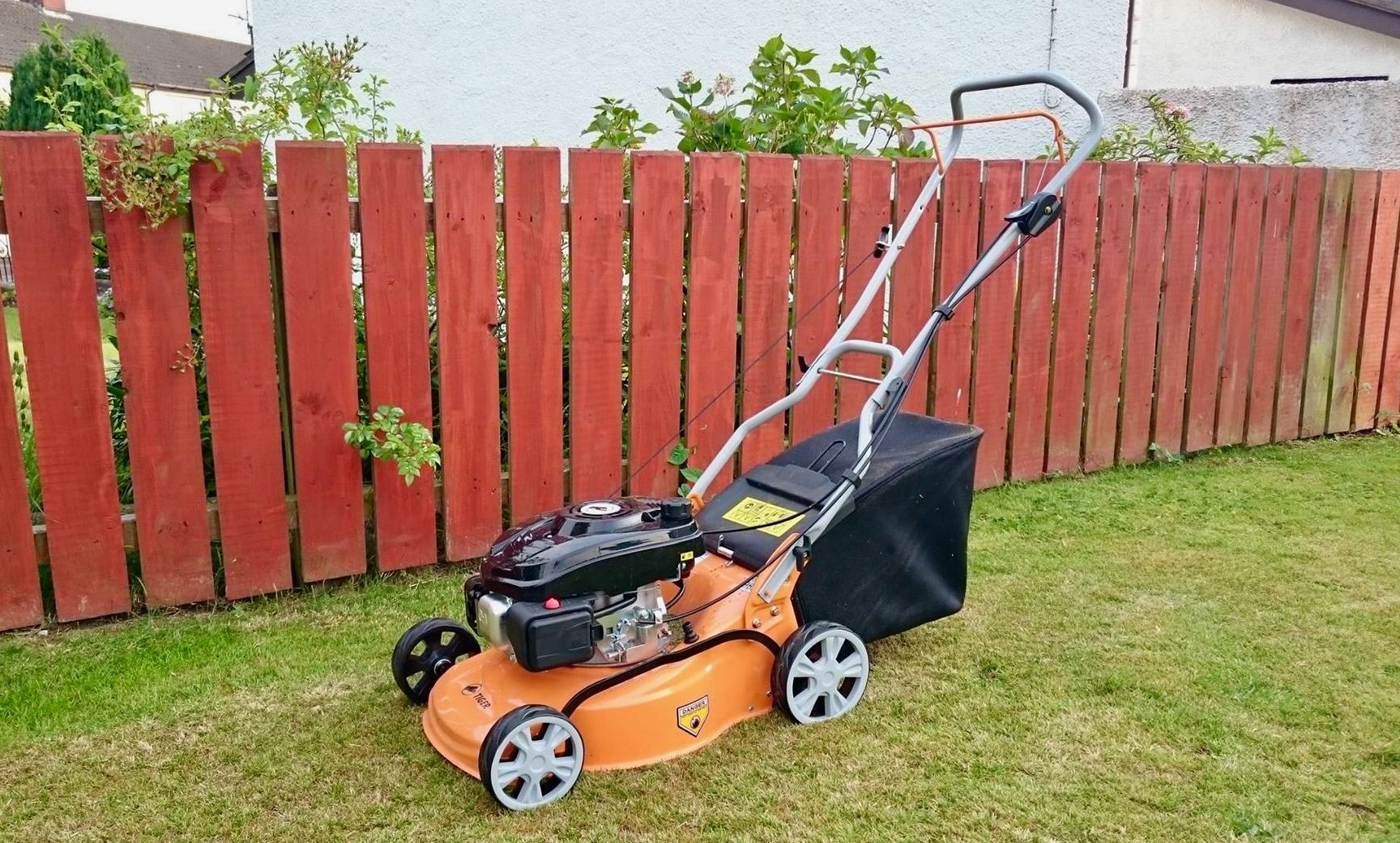
More wheeled mowers, such as this Tiger brand machine, are sold in the UK today, than all other types put together. Image Credit: Author
A subsidiary of The Toro Company, British machinery manufacturer Hayter, is synonymous with the design and manufacture of highly regarded, roller mowers. Photo Credit: Kev Gregory
Roller Mowers
There’s no denying it — a striped lawn just looks amazing. It’s the kind of finish that makes your garden stand out and gives it that polished, professional look. The best part? It’s a lot easier to achieve than most people think. So, what’s the secret? A roller mower, of course, plus a little patience and planning.
Here’s how it works: A rotary roller mower usually has two wheels at the front and a roller at the back — effectively replacing the rear wheels you’d find on a standard wheeled mower. A cylinder roller mower, on the other hand, typically combines a large rear roller with a smaller one at the front. Irrespective of which type you choose, the magic happens with that rear roller. As it moves over your lawn, it gently bends the grass in one direction. When you turn the mower around and come back the other way, the roller bends the grass the opposite way. The result? Those iconic light-and-dark stripes that instantly elevate your garden game to a new level.
With a bit of practice and a steady hand, you’ll have a championship winning finish, that wouldn’t look out of place at Wimbledon.
Advantages Of Choosing A Roller Mower
Roller mowers come in a wide range of models — with petrol-powered, corded electric, battery electric, and even good old-fashioned hand-powered mowers too. No matter which power source you choose, roller mowers are not just about creating those iconic stripes, but bring a bundle of extra benefits to the table:
- Reduced risk of 'Wheel Drop': You know that frustrating moment when a wheel slips into a flower bed and undoes hours of careful edging? Roller mowers reduce that risk. They let you mow right up to the edge — and even slightly beyond — with a little care. That means less time trimming, and more time admiring your beautifully finished borders;
- Ease of use on softer ground: Unlike wheels, which concentrate the mower’s weight in small areas, a roller spreads the weight more evenly. This helps prevent the machine from sinking in and damaging the turf — especially helpful in damp conditions, or on newly laid lawns;
- Reduced risk of scalping: Whereas a wheeled mower might straddle a bump and cut too close, a roller mower simply glides over it. Scalping doesn’t just look bad — repeated scalping can damage your mower;
- Firming action: On heavier machines, the roller also has a very definite firming action, which can usefully flatten unsightly divots and worm casts, albeit on lighter machines, the firming effect will not be as noticeable.
Disadvantages Of Choosing A Roller Mower
Roller mowers have a lot going for them — but before you dive in, it’s worth knowing about a few potential drawbacks, so you can decide if they’re the right fit for your lawn and lifestyle:
- Purchase cost: A roller mower tends to be more expensive than a wheeled equivalent, since roller machines are more complex to manufacture. This said, some value brands have introduced roller mowers at lower price points to the UK market over recent years. So, whilst they typically remain more expensive than wheeled and hover mowers, the premium payable has reduced significantly;
- Running costs: You should expect maintenance costs to be comparable with wheeled machines, whilst running costs will be slightly greater. Roller machines tend to be heavier than wheeled mowers, and therefore running costs will be slightly greater – especially on self-propelled variants, where the engine provides motive as well as cutting power;
- Less choice: These days, you’ve got more roller mowers to choose from than ever before — especially at lower price points - but when it comes to sheer variety, wheeled mowers still steal the show;
- Agility: Roller mowers aren’t the quickest to turn. So, if your lawn has lots of curves, tight corners, or obstacles, mowing can take a bit longer. That said, some models feature split (or 2-piece) rollers, which make turning easier and reduce the risk of scuff marks on the grass;
- Reduced mulching options: Prefer to mulch your clippings instead of collecting them? That’s where roller mowers can fall a little short. Some do come with mulch plugs, but many don’t, so product options may be more limited than for wheeled machines;
- Slopes and banks: Just like their wheeled cousins, roller mowers aren’t built for steep slopes or banks. If your garden includes challenging terrain, a hover mower, or a robotic mower might be a smarter (and likely, safer) alternative.
Summary
In conclusion,
roller mowers are a fantastic choice for anyone who takes pride in their lawn’s appearance — especially if you're aiming for that classic striped finish. That said, their strengths come with a few trade-offs. Roller mowers can be less nimble than wheeled models, meaning
mowing may take a little bit longer, especially on more complex lawns. And like wheeled mowers, they’re
not designed for steep slopes or banks. However, if aesthetics are a top priority, a roller mower can take your garden to the next level.
Hover Mowers
If you lived through the 1980s in the UK, you’ll probably remember the battle for the heart – and wallet – of the nation’s gardeners, between the erstwhile Qualcast Concord and Flymo’s family of hover mowers.
Whilst Qualcast’s Marketing Department exclaimed, “It’s a lot less bovver than a hover!”, thousands of Britons disagreed.
Today, many still do.
Unlike conventional wheeled or roller mowers that maintain constant ground contact, hover mowers operate by generating a cushion of air beneath the deck, enabling them to float slightly above the lawn's surface. This air cushion, similar in principle to a hovercraft, significantly reduces friction, allowing for enhanced manoeuvrability and multidirectional movement. The result is a highly agile mowing experience, especially effective on uneven, or sloped, terrain.
Advantages Of Choosing A Hover Mower
- Affordability: Along with wheeled mowers, hover mowers are among the lowest cost models available, making them popular with gardeners intent on cutting costs, as well as grass;
- Manoeuvrability: Because hover mowers float on a cushion of air rather than resting on wheels or rollers, they are more manoeuvrable on the lawn. While traditional wheeled and roller mowers tend to follow straight lines, hover mowers can move effortlessly in any direction. This makes them especially well-suited for lawns with irregular shapes or tight spaces where turning can be tricky;
- Ideal for slopes and banks: Their contactless design also makes hover mowers the superior choice for tackling banks and steeper slopes. Since they don’t rely on traction or ground contact, they require significantly less physical effort to operate on inclines. Watch any professional groundskeeper trimming a steep bank, and chances are they’re using a hover mower — not a wheeled or roller model;
- Good for beds and borders: Hover mowers can shine when working around beds and borders. With no risk of 'wheel drop', you can trim confidently along curved or uneven edges. Thanks to their air-cushion design, they can get right up to the edge and, with care, even trim slightly beyond it;
- Access all areas: Because there are no wheels or rollers to restrict access, hover mowers can cut closer to fences, trees, and hedges than many rotary or cylinder models, making them a more precise and practical option for complex garden designs;
- Easy to assemble: If you're purchasing your mower online, or from a national reseller, it will often come part built. The good news is that with no wheels to fit, hover mowers are among the easiest machines to assemble.
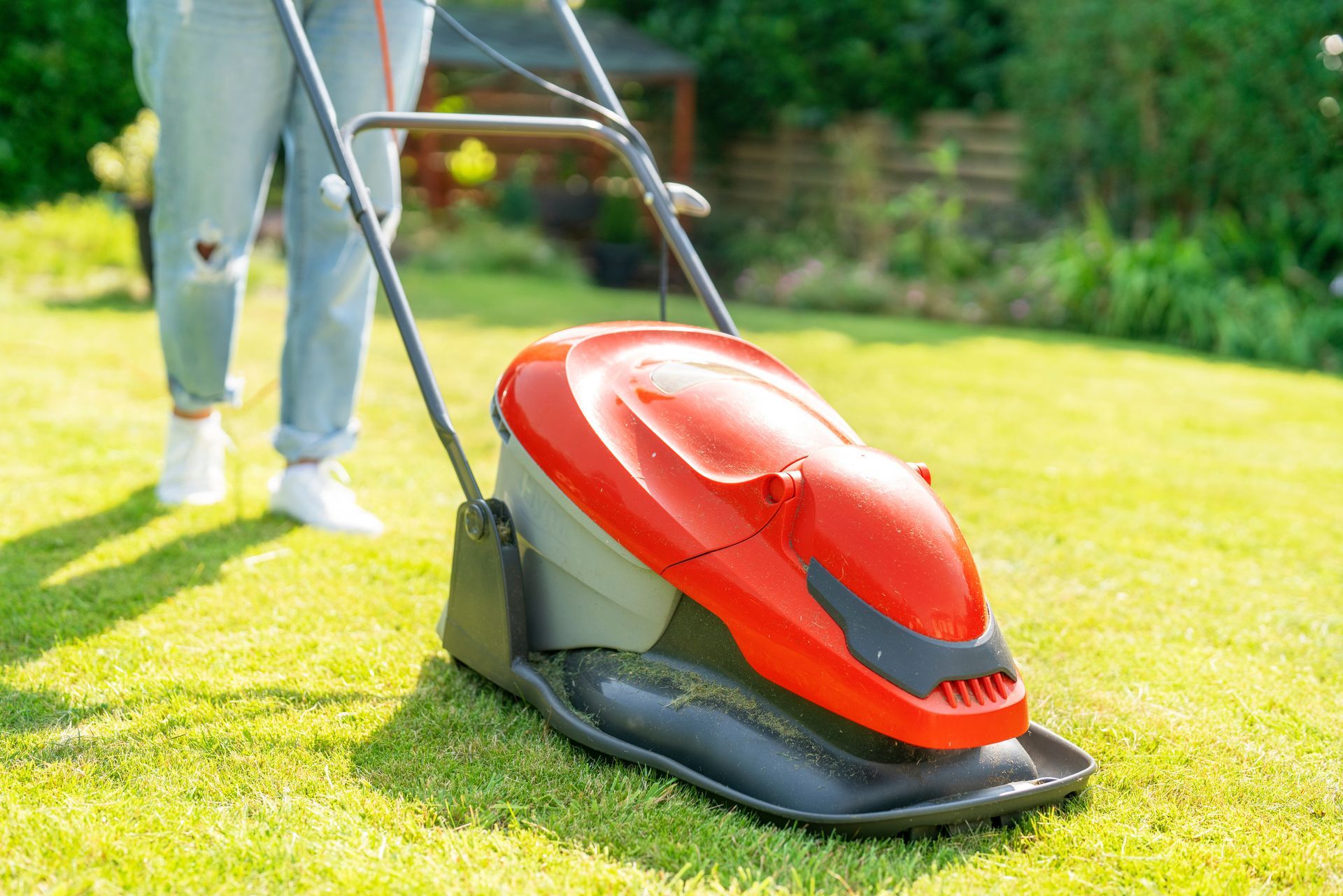
Developed here in the UK by Danish industrialist Karl Dahman, hover mowers have transformed how thousands of Britons cut and care for their lawn. Photo Credit: Irene Miller

Sleek, powerful, and stylish, this modern, lithium-ion battery powered, cordless, hover mower, manufactured by Italian machinery specialist, STIGA, is ideal for gardens up to 100 square metres. Photo Credit: STIGA SpA.
Disadvantages Of Choosing A Hover Mower
Downsides? Well yes, there are a few:
- No self-propelled option: If you’re looking for a self-propelled mower, hover mowers won’t fit the bill — and that’s by design. Their operation depends entirely on manual control. As propulsion systems would interfere with the air cushion that allows them to hover, they're hand-propelled by design;
- No striped finish option: Unfortunately, hover mowers aren’t compatible with rollers. Since they rely on a stable cushion of air to operate, adding a roller would disrupt airflow, destabilise the mower, and make it awkward to handle. As a result, stripes — and rollers — are off the table;
- The long and the short of it: Whilst hover mowers are great for cutting shorter grass, they’re generally not as effective as a wheeled, rotary mower, when cutting longer grass. So, whilst some wheeled mowers have a maximum cutting height of 110mm, few hover mowers have a maximum cutting height greater than 40mm. Furthermore, whilst the cutting height on most wheeled and roller mowers can be adjusted on demand by pulling a simple lever, height adjustment on many hover mowers requires the use of tools, and sometimes, partial disassembly of the machine;
- Collection: While many modern hover mowers come equipped with collection boxes, they may not collect clippings as efficiently as their wheeled counterparts. As the collection box fills, the mower becomes heavier, which can affect hover stability and consistency of cut. Furthermore, grass box size tends to be smaller than many comparable wheeled and roller mowers;
- Limited product options: There are fewer hover mowers to choose from, than wheeled or rotary models. Indeed, some leading brands don't even offer a hover option, whilst the selection of models available for larger lawns is somewhat limited;
- Transport: Whist hover mowers are more manoeuvrable on the lawn, they're less manoeuvrable off it. Unless the mower is fitted with retractable or detachable rear wheels, it can prove awkward and cumbersome to transport. Rear wheels are often supplied as standard, or available as an extra-cost option on many commercial grade machines, but are less common on consumer models.
Summary
For smaller, domestic lawns, hover mowers have much to commend them – being easy to use, and ideal for use in confined spaces and on lawns surrounded by beds and borders. Alongside robotic mowers, hover machines are a great choice too, for use on banks and slopes which otherwise would prove difficult and possibly unsafe to cut, using a conventional mower. But, for other applications, most British gardeners will choose a wheeled, roller, or combi machine.
Combi Mowers
Combi mowers are designed to combine the benefits of roller mowers with the advantages of a wheeled machine, whilst eliminating the downsides associated with both. They are typically found at the smaller end of the market and are usually – but not exclusively – powered by either a mains-electric, or cordless, battery powered motor.
Outwardly, a combi-mower resembles a standard wheeled mower. However, between the rear wheels sits a roller, whose function is to leave a striped finish on the lawn after cutting.
Advantages Of Choosing A Combi Mower
- Striped finish: The rear roller will deliver a striped finish, making it suitable for formal lawns and gardens;
- Weight distribution: On models with a weight bearing rear roller, the weight of the mower is spread across a greater surface area than a pair of wheels alone. This allows the weight of the mower to be distributed more evenly, and helps reduces the likelihood of the mower digging into the ground, damaging the sward;
- Flexibility: On models featuring a detachable rear roller, you can switch stripes on when you want them, and switch them off when you don't, simply by removing the roller.
Outwardly, this highly regarded LawnMaster 48-volt, 41cm machine looks like a regular, wheeled mower. Image Credit: Cleva Europe
A closer look underneath this machine, reveals a roller, positioned between the rear wheels. Image Credit: Cleva Europe
Disadvantages Of Choosing A Combi Mower
However, just as with roller, wheeled and hover mowers, combi-mowers have a few drawbacks and limitations too:
- Effectiveness: Due to their frequently small-size and lightweight construction, the stripe effect may not prove as noticeable or as long-lasting with a combi-mower, as when using a heavier, roller mower;
- Limited choice: Combi-mowers typically are available in only a limited selection of sizes, primarily at the smaller end of the market. If you’ve a larger garden, your choice of machine will be more limited;
- Banks and slopes: Like both wheeled and roller mowers, combi-mowers are inherently unsuitable for use on steep banks and slopes.
Summary
For smaller gardens, combi-mowers can prove a great choice, bridging the gap between fully-fledged wheeled and roller machines.
Wheeled, Roller, Hover Or Combi-Mower?
So, should you choose a wheeled mower, a roller mower, a hover mower, or a combi mower? Truth be told, there’s no right or wrong answer. There’s only the right answer for your you, and for your lawn.
For the most gardens, a wheeled mower offers the best all-round solution — it's cost-effective, easy to operate, and available in a wide variety of models to suit different needs and budgets. Hence, more of us choose a wheeled machine in the UK, than any other type of mower.
However, if visual impact is a top priority and you're aiming for that classic striped, quintessentially British finish, then a roller mower — or a combi model, with integrated roller functionality — is a garden shed essential. And if you’re tasked with maintaining banks and slopes, then you’ll almost certainly wish to consider a hover mower, or possibly even, a robotic mower instead.

